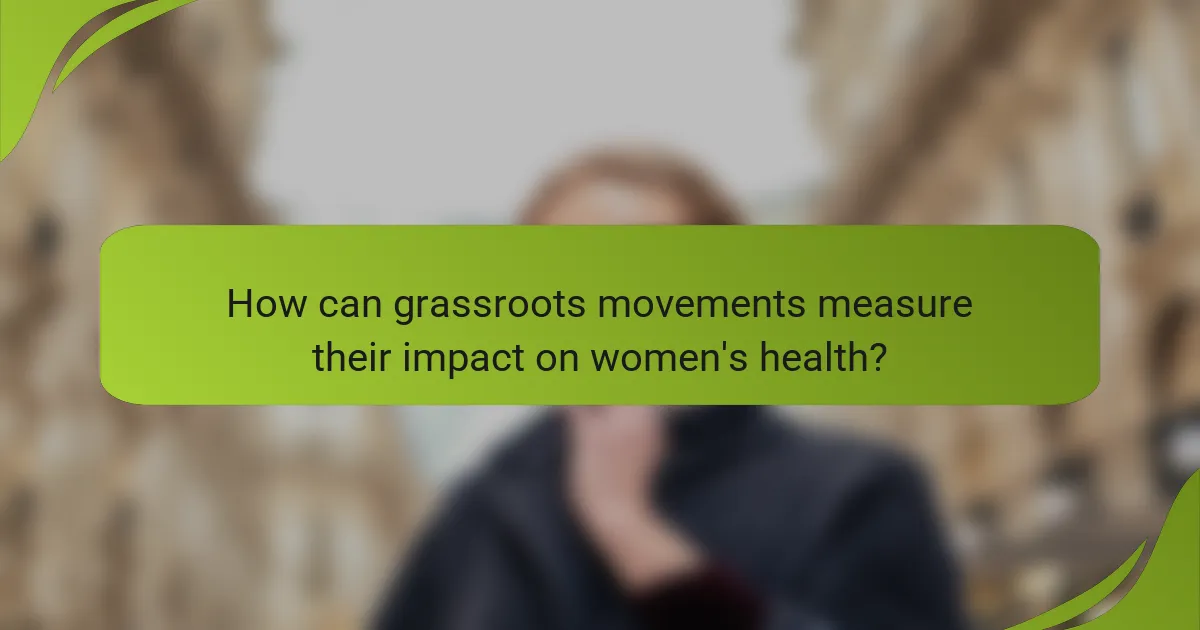Grassroots movements play a crucial role in advancing women’s health initiatives by employing effective strategies such as community engagement, partnerships, and advocacy for policy changes. These efforts have led to improved access to services and better maternal health outcomes, while also raising public awareness about critical health issues. However, these movements often face challenges, including funding limitations and resistance from political entities, which can hinder their overall effectiveness.

What strategies are effective for grassroots women’s health initiatives?
Effective strategies for grassroots women’s health initiatives include community engagement, partnerships with local health organizations, social media campaigns, fundraising efforts, and advocacy for policy changes. These approaches help mobilize resources, raise awareness, and create lasting impact in women’s health.
Community engagement programs
Community engagement programs focus on involving local women in health initiatives, fostering ownership and participation. These programs can include workshops, health fairs, and support groups that address specific health issues relevant to the community.
To maximize impact, tailor programs to the unique needs of the community, ensuring they are culturally sensitive and accessible. Regular feedback from participants can help refine these initiatives and enhance their effectiveness.
Collaborations with local health organizations
Collaborating with local health organizations can amplify the reach and effectiveness of grassroots initiatives. These partnerships can provide access to resources, expertise, and networks that are crucial for successful health programs.
Establishing clear roles and responsibilities within the collaboration is essential. Consider creating joint events or campaigns that leverage the strengths of each organization, ensuring a unified approach to women’s health issues.
Utilizing social media for awareness
Social media is a powerful tool for raising awareness about women’s health initiatives. Platforms like Facebook, Instagram, and Twitter can be used to share information, promote events, and engage with the community.
To effectively utilize social media, create a content calendar that includes educational posts, testimonials, and calls to action. Engaging visuals and interactive content can help capture attention and encourage sharing among followers.
Fundraising events and campaigns
Fundraising events and campaigns are vital for sustaining grassroots women’s health initiatives. These can range from charity runs and bake sales to online crowdfunding campaigns. Each event should clearly communicate its purpose and how funds will be used.
Consider leveraging local businesses for sponsorships or donations to enhance fundraising efforts. Engaging the community through fun and interactive events can also increase participation and support for the cause.
Advocacy for policy changes
Advocacy for policy changes is crucial for addressing systemic issues in women’s health. Grassroots movements can influence local and national policies by mobilizing community members to voice their concerns and needs to policymakers.
Effective advocacy involves educating the community about relevant health policies, organizing campaigns to raise awareness, and collaborating with other organizations to strengthen the message. Building relationships with local legislators can also facilitate dialogue and promote change.

What successes have grassroots movements achieved in women’s health?
Grassroots movements have significantly advanced women’s health by increasing access to services, improving maternal health outcomes, driving legislative changes, and raising public awareness. These initiatives often rely on community engagement and advocacy to address local health needs effectively.
Increased access to reproductive health services
Grassroots movements have played a crucial role in enhancing access to reproductive health services, particularly in underserved areas. By organizing community clinics and outreach programs, these movements have helped women obtain essential services such as contraception, prenatal care, and screenings.
For example, initiatives like mobile health units have reached rural populations, providing vital reproductive health resources where traditional healthcare facilities may be lacking. This approach not only increases service availability but also fosters trust within communities.
Improved maternal health outcomes
Through targeted advocacy and education, grassroots movements have contributed to improved maternal health outcomes. Programs focused on prenatal education and support have empowered women to seek timely medical care, leading to healthier pregnancies and reduced maternal mortality rates.
Collaborations with local healthcare providers have also been instrumental in ensuring that women receive comprehensive care throughout their pregnancy. These partnerships often include training for healthcare workers on culturally sensitive practices that resonate with the community.
Legislative changes supporting women’s health
Grassroots movements have successfully influenced legislative changes that support women’s health rights. By mobilizing community members and raising awareness about health disparities, these movements have advocated for policies that expand access to healthcare and protect reproductive rights.
For instance, campaigns have led to the introduction of laws mandating insurance coverage for reproductive health services, ensuring that women can access necessary care without financial barriers. These legislative victories often result from persistent advocacy and coalition-building efforts.
Enhanced public awareness and education
Raising public awareness about women’s health issues is a key success of grassroots movements. Through workshops, social media campaigns, and community events, these initiatives educate women about their health rights and available resources.
Moreover, grassroots efforts often focus on breaking down stigma surrounding topics like reproductive health and mental wellness. By fostering open conversations, they empower women to seek help and advocate for their health needs more effectively.

What challenges do grassroots movements face in women’s health?
Grassroots movements for women’s health encounter several significant challenges that can hinder their effectiveness. These obstacles include a lack of funding and resources, resistance from political entities, barriers to community engagement, and limited access to healthcare professionals.
Lack of funding and resources
One of the primary challenges grassroots movements face is securing adequate funding and resources. Many initiatives rely on donations, grants, or volunteer efforts, which can be inconsistent and insufficient to sustain long-term projects.
To overcome this, organizations can explore diverse funding sources, such as crowdfunding, partnerships with local businesses, or applying for government grants. Building a strong network can also help in pooling resources and sharing costs.
Resistance from political entities
Grassroots movements often encounter resistance from political entities that may not prioritize women’s health issues. This can manifest in the form of legislative hurdles, lack of support for initiatives, or even active opposition to proposed changes.
To navigate this challenge, movements should engage in advocacy efforts, such as lobbying for policy changes or building coalitions with other organizations. Educating policymakers about the importance of women’s health can also help in gaining their support.
Community engagement barriers
Effective community engagement is crucial for grassroots movements, yet barriers such as cultural differences, language barriers, and mistrust can impede outreach efforts. These factors can limit participation and support from the very communities these initiatives aim to serve.
To enhance engagement, organizations should tailor their outreach strategies to the specific needs and preferences of the community. Utilizing local leaders and influencers can also help bridge gaps and foster trust.
Limited access to healthcare professionals
Grassroots movements frequently struggle with limited access to healthcare professionals, which can restrict the quality and scope of services offered. This issue is particularly pronounced in underserved areas where healthcare resources are scarce.
To address this, movements can collaborate with local health providers to create mobile clinics or health fairs that bring services directly to the community. Training community health workers can also help expand access and provide essential support.

How can grassroots movements measure their impact on women’s health?
Grassroots movements can measure their impact on women’s health through various methods, including participant surveys, tracking health outcomes, and analyzing social media engagement. These strategies help organizations assess effectiveness and identify areas for improvement.
Surveys and feedback from participants
Surveys are a direct way to gather feedback from participants about their experiences and perceived benefits of health initiatives. They can include questions on satisfaction, knowledge gained, and changes in health behavior. Utilizing both quantitative and qualitative questions can provide a comprehensive view of the program’s impact.
To maximize response rates, consider offering incentives or ensuring anonymity. Regularly conducting these surveys, perhaps quarterly or biannually, can help track changes over time and adjust strategies accordingly.
Tracking health outcomes over time
Monitoring health outcomes involves collecting data on specific health indicators before and after program implementation. This can include metrics like rates of screenings, vaccination uptake, or improvements in chronic conditions. Establishing a baseline measurement is crucial for comparison.
Collaborating with local health departments or clinics can enhance data collection efforts. Aim for a time frame of at least six months to a year to observe significant changes, and ensure that data privacy regulations are followed when handling personal health information.
Analyzing social media engagement metrics
Social media engagement metrics, such as likes, shares, comments, and follower growth, can indicate the reach and resonance of health initiatives. High engagement levels often correlate with increased awareness and community interest in women’s health issues. Tools like Google Analytics or social media insights can help track these metrics effectively.
Regularly reviewing these metrics can inform content strategies and highlight successful campaigns. Consider setting specific goals for engagement, such as increasing shares by a certain percentage over a defined period, to guide efforts and measure success.

What role do partnerships play in grassroots women’s health initiatives?
Partnerships are crucial in grassroots women’s health initiatives as they enhance resource sharing and amplify the impact of programs. Collaborating with various stakeholders allows organizations to leverage expertise, broaden outreach, and address challenges more effectively.
Access to additional resources and expertise
Forming partnerships with healthcare providers, NGOs, and academic institutions can significantly enhance the resources available to grassroots initiatives. These collaborations often provide access to funding, training, and specialized knowledge that might not be available to smaller organizations.
For example, a local women’s health group might partner with a university to conduct research on community health needs, gaining insights that inform their programs. This access to expertise can lead to more effective interventions and better health outcomes for women.
Broader outreach and influence
Partnerships enable grassroots organizations to extend their reach and influence within the community. By collaborating with other groups, they can tap into established networks and gain credibility, which helps in mobilizing support and resources.
For instance, a coalition of women’s health advocates can organize larger events or campaigns that draw more attention to critical issues, such as reproductive rights or maternal health. This collective effort can lead to increased public awareness and policy changes that benefit women’s health on a larger scale.


